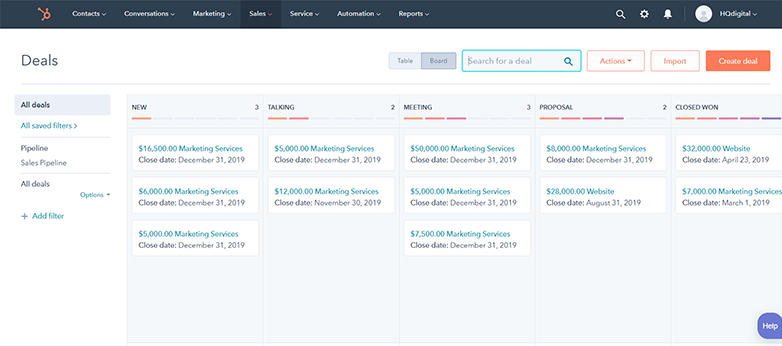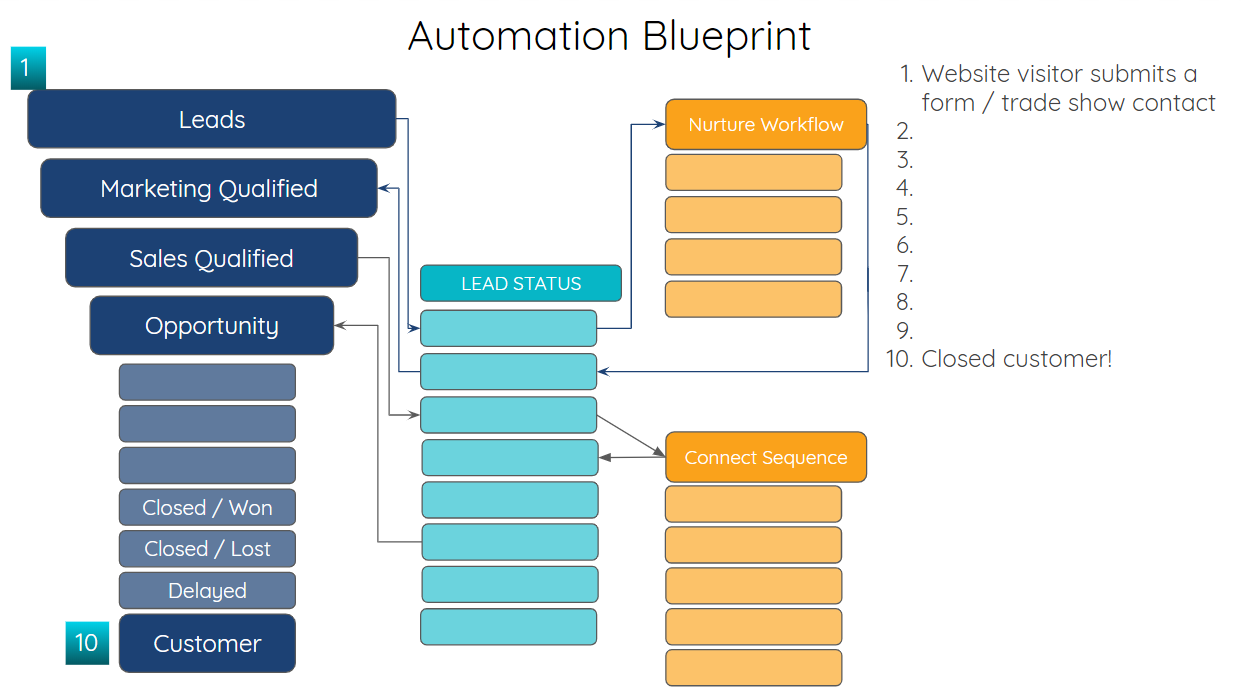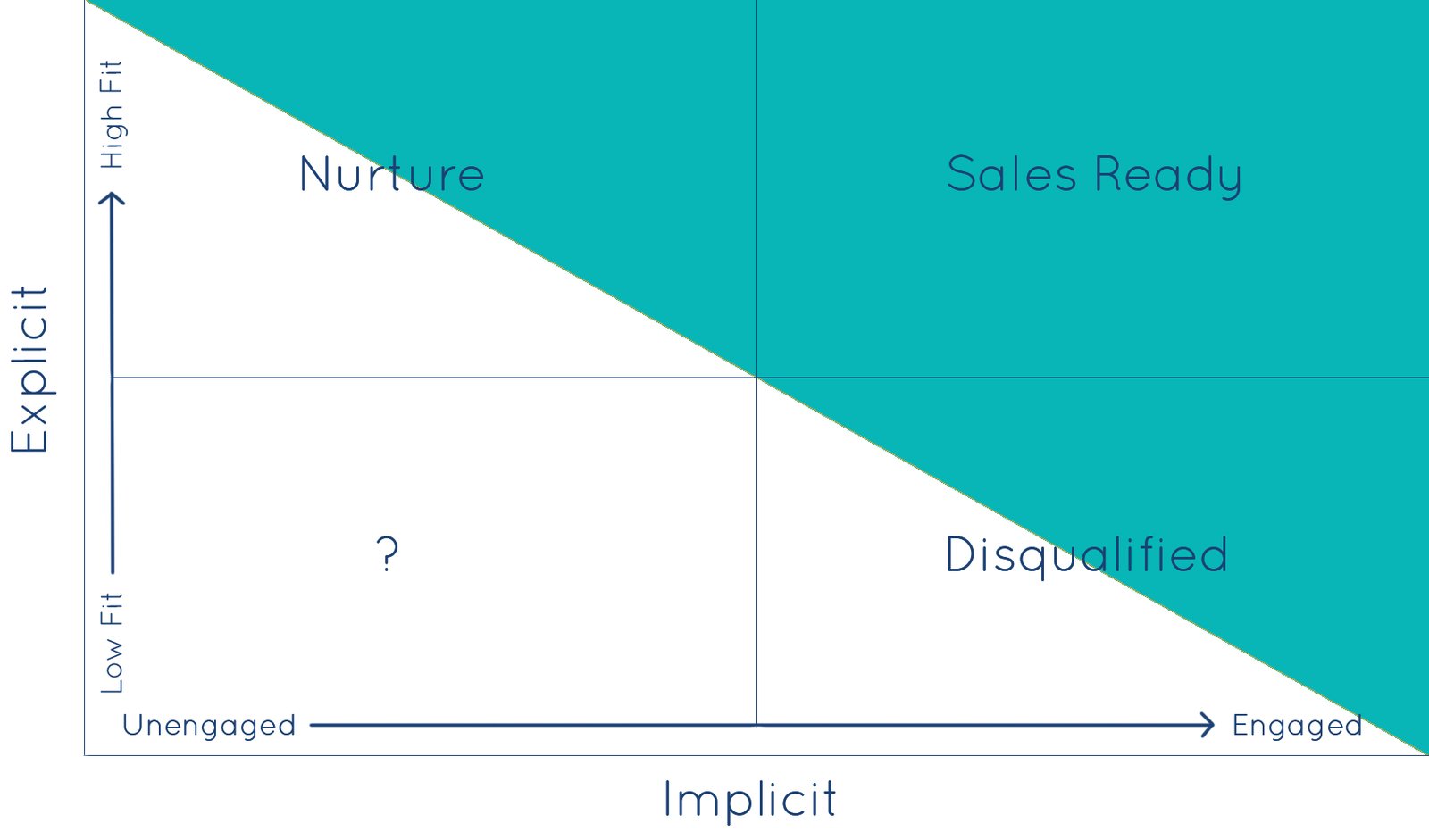Editor's Note: This blog was originally published in July 2018 and updated in May 2019 and January 2024.
HubSpot CRM is a great tool to help sales leaders gain visibility into their pipeline and to implement measurable change in their organization.
Click here to get the HubSpot CRM now. It’s free and it’s awesome, we promise.
Setting up well-defined deal stages is an important first step to gaining insight into your sales funnel and improving sales team performance.
What Are Deal Pipelines and Stages in HubSpot?
Deal stages represent the stages or steps in your sales pipeline that signify to your sales team that an opportunity is moving toward closing. Your sales pipeline begins where your marketing funnel ends.
HubSpot Sales Hub Professional and Enterprise teams can create up to 50 different pipelines. This is useful for organizations that have products or services with distinctively different sales processes or multiple product offerings. You can also create a pipeline specifically for up-selling existing customers or a pipeline for annual renewals.
In HubSpot CRM, your deal stages are represented as lanes across your sales process, providing a visual representation of your pipeline.

As a deal progresses, it moves across the deals board. Some organizations have their sales team members physically drag the cards across the lanes, while others automate this functionality, depending on the culture of the sales organization.
You can create and save filters in HubSpot to quickly view deals of a certain size, deals expected to close this month, or deals in a specific industry.
There is also a table view option, which is handy for sorting deals by deal owner, current deal stage, or projected close date.
Determining the Right Deal Stages for Your HubSpot Sales Pipeline
Each deal stage should signify that an action has been taken by your sales team, such as “Presentation Scheduled” or "Proposal Sent." You do not want any ambiguity here. Make sure there are obvious indicators that align with the various stages. We usually recommend companies start off with between 6-8 stages. Some will simplify to as few as 4, and others expand to 15 or more.
Here is a very simple example of a pipeline with five deal stages.
- Discovery call completed
- Meeting scheduled
- Proposal requested
- Closed /Won
- Closed/Lost
For each stage, you can specify the percentage likelihood-to-close, providing a streamlined view of your revenue forecast. Update these regularly to ensure your monthly, quarterly, and annual projections are accurate.
When moving deals from one stage to the next, you can also require additional deal properties to be entered. For example, when moving to the "closed - lost" stage, you should require a reason that the deal was lost. Think through other transition points, and whether there are any specific data points that you want to inject along the way.
When to Create a New Deal in HubSpot CRM
It’s important that your deal stages are well-defined and that everyone on your sales team understands them.
One of the most common questions companies have when beginning to use deal stages is when they should create a new deal. Your first deal stage should be the first action committed to by a lead to start your sales process. “Discovery call scheduled” or “initial appointment booked” are common initial deal stages.
Resist the urge to create new deals too early. Doing so will drag down your close rate and muddy your sales data. Your CRM system should be used for active sales pipeline management, not as a list of every company you hope to work with one day. There are plenty of other HubSpot tools to manage MQLs, leads, contacts, and other prospects.
Default HubSpot Deal Stages and Win Probabilities
Default settings in HubSpot CRM include seven deal stages with preset win probabilities.
- Appointment scheduled (20%)
- Qualified to buy (40%)
- Presentation scheduled (60%)
- Decision maker bought-in (80%)
- Contract sent (90%)
- Closed won (100% won)
- Closed lost (0% lost)
Examples of HubSpot Deal Stages for SaaS and Manufacturing Companies
We find that slight modifications to the default deal stages help sales teams better understand and adopt HubSpot CRM. Of course, the right deal stages for you will depend entirely on what your sales process is, what your sales team looks like and what your goals are.
Here is an example of a SaaS sales pipeline:
- Demo requested
- Decision maker brought in
- Proposal requested
- Proposal sent
- Closed/Won
- Closed/Lost
- Delayed/Deferred
And here is an example for a manufacturing company:
- New opportunity
- Initial meeting scheduled
- Assessment
- Decision maker brought in
- Sample requested
- Sample delivered
- Proposal requested / RFP
- Proposal sent
- Closed/Won
- Closed/Lost
- Delayed/Deferred
Again, it is most important that the deal stages are well understood by your sales team, and provide your leadership team with a clear view of your pipeline or any potential obstacles.
How to Set Up or Modify Your Deal Stages in your HubSpot Portal
Step 1: Log into HubSpot. Click “Sales” and “Deals” from the main menu.
Step 2: Select your pipeline.
Note: Only HubSpot Professional + Enterprise users can set up multiple pipelines.
Step 3: Add or edit your deal stages.
Here you can make edits to your pipeline's stages.
- Click to the left of a stage and drag to change the order of stages in your pipeline.
- Change the name of any stage by clicking the Stage name field.
- Click Delete to delete a stage.
- Use the Win probability dropdown menu to change the percent of closing a deal at that stage.
- Edit properties that are presented to users when a deal is moved to this stage.
- Create a new deal stage by clicking Add a deal stage and set the stage name and win probability. Any newly created deal stages will appear in the deals view for all users in your account.

That’s it! Start creating deals and drag them across your deals board to the appropriate stage. You’ll instantly get a visual representation of your sales pipeline and be well on your way to improving revenue generation performance.
Bonus Quick Start Implementation Tips:
- Think through your whole sales process, lifecycle stage transitions and lead statuses strategically before you begin.
- Start with HubSpot’s templated deal stages or our recommended modification if you’re not sure where to begin.
- Ask your sales team for input on close rates and win probabilities.
Want to learn more about the power of HubSpot? Get free advice from the HubSpot experts.








